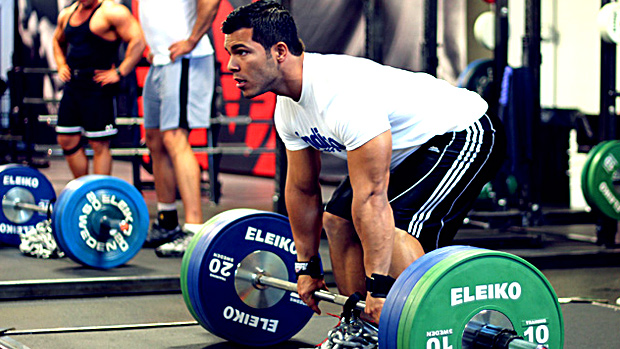The Missing Ingredient That Kills Progress
Volume is an overlooked component of many training programs.
Volume refers to the total weight lifted in the training session, defined as (weight)*(reps at that weight)*(sets at that rep scheme) for each weight used in the training session and then added together.
So, a deadlifting session might look something like this:
- 135 x 5 = 675
- 225 x 5 = 1125
- 315 x 3 = 945
- 405 x 2 = 810
- 425 x 2 x 4 = 3400
If we add these together we get 675 + 1125 + 945 + 810 + 3400 = 6955 pounds of volume.
Studies have generally confirmed that volume is one of the primary concerns in training for strength and hypertrophy. That is, as volume increases, we tend to get bigger and stronger unless something else is holding us back. As we do more and more work, we get more jacked.
This shouldn't come as too much of a surprise. After all, we all know that the guys who get further are usually the ones who put in more time with the iron, given that they also keep their diet and recovery in check. Doing more work than the other guy is generally going to mean you're going to get better than him.
Since the volume equation is comprised of three different variables, there are three different ways to increase our volume from workout to workout.
- You can lift more weight at the same set and rep scheme you did last workout – one workout you do biceps curls at 4x12 with 50 pounds, and the next workout you do 4x12 with 55 pounds.
- You can lift the same weight for more reps per set – 4x12 with 50 pounds vs. 4x15 with 50 pounds.
- You can perform more sets per workout – 4x12 with 50 pounds vs. 5x12 with 50 pounds.
In general, we expect volume to increase over time. We don't have to lift more volume over every single workout, but if we look at a long-term graph we should expect to see an upward trend.
If the graph of our volume is flattening out despite our attempts to increase it, we may be reaching our ultimate limits, or there may be something interfering with our training. At this point we can stagnate or maintain, but not improve. If we see a downward trend in the graph, that means we're getting worse.
For this reason, you need to track your volume regularly. While it can be done with pen and paper or on a computer spreadsheet, there are online services that make it much easier for you.
Volume training for size gains can be extremely confusing, and much more so than volume training for strength. Since you're probably going to use more than one exercise per body part, how do you track that?
Dips and triceps pushdowns are both exercises that target the triceps, but since they have different mechanical advantages, it's unlikely that you're going be able to lift the same weight in both.
This doesn't mean dips are inherently better than triceps pushdowns – just that it's going to be measured on a different magnitude. Then of course there are compound exercises.
A bench press works the triceps, but it also works the pecs and the deltoids. Which muscle should the volume be accounted for? If splitting it up, which muscles get which percentage of the compound lift? There are two general solutions:
- Don't worry about it! Instead, focus on improving your volume with each specific lift each time you enter the gym instead of each time you use an exercise for a specific muscle group. That means if you've got a total volume of X for the triceps pushdown, you aim to do more the next time you do a triceps pushdown, even if you're going to be doing other triceps exercises for the next few workouts.
- Another solution is to focus on one lift per workout. Today you might want to improve your volume on your bench or on your dumbbell biceps curl, but you'll let the rest of your lifts remain at a similar volume to what you've done in previous workouts.
Training for strength is a little different than training for size. Training to get strong involves high intensity lifts, typically in the 1-6 rep range and above 75% of our 1RM.
Since this is the rep range that provides the neurological adaptations and muscle fiber recruitment we need to handle heavy weights, most strength training should be done in this range.
When calculating your volume when training for strength, it's important to only count the reps we do at greater than 75% of 1RM. If we use the deadlift example from above, the numbers now look like this:
- 405 x 2 = 810
- 425 x 2 x 4 = 3400
And when we add those together, we get a total of 4210 pounds.
That's a significant drop from our previous volume of 6955 pounds. However, it's much more accurate because the warm-up sets are essentially just pointless weight when training for strength. They aren't going to do much to add to the total, so there's no point in counting them.
While speed sets, band/chain sets, and other non-traditional loading methods might fall a little out of our accepted range, they should still be counted because their unique properties enable us to get more out of them than their base bar weight would imply.
So, volume training for strength is a lot simpler than training for hypertrophy. Since we aren't counting high-rep sets, we're going to see significantly less volume when training for strength than when training for hypertrophy, but then again, strength athletes aren't endurance athletes and shouldn't train like them!
As with volume training for hypertrophy, it's probably best to simply track volume for each exercise individually and try to improve that over time rather than trying to convert everything into one larger number.
More advanced athletes may need to focus more on the volume of their accessory work than their main work. This will work better at correcting individual weaknesses than main work will.

Periodization is the bread and butter of strength training. Studies have shown that programs that feature any kind of periodization are vastly superior to those that have none.
Generally, the two overall purposes of periodization are to 1) increase volume over time and 2), do so safely.
Since a lot of people spin their wheels trying to gain strength when they don't actually add any volume on their own, periodization often means a huge jump up because following the program makes it easy to improve volume over time without even thinking about it or having to do much math.
However, provided that you aren't going too crazy, you can actually just create your own self-regulated, self-periodized program simply by adding volume.
Calculate your volume for the current workout, and if you're down a little bit from the last one, just do a few more reps or sets, either with your working sets or something a little lighter if you're already getting tired out. It's as simple as that.
1 Too much, too soon
The biggest problem with people who convert to volume-based training programs is that they immediately want to jump in and do a lot.
Since more work equals more gains, they discover volume training, try to do a much greater workload than what they're used to, and then quickly burn out because it's too much.
The solution is easy – don't overdo it. You want to increase your volume, but don't do it in fits and starts. Keep that graph trending upward, but there's no need to suddenly do 20 sets of 3 high-intensity deadlifts in the name of building strength.
2 Recovery
Volume is, all other variables remaining the same, the key indicator of your improvement. But that's the thing: There are a lot of other variables, and they don't always stay the same. Your level of preparedness for training varies widely based on psychological and physical factors.
If you only got three hours of sleep the night before, or haven't eaten anything all day, or your diet is totally off kilter for a week, you're not going to be in peak shape. That means you may find it difficult to show up to the gym and do more volume than last time.
During such times, just show up and get a maintenance workout in. Don't obsess too much over it, but roll with the punches and keep moving.
Consider, too, that during a weight cut, whether as a bodybuilder or strength athlete, you're going to have worse recovery than usual. You'll need more sleep to recover between workouts, and even then it may be difficult to add strength or size.
You should probably focus on maintaining what you have at this point instead. Piling on the volume when your recovery isn't perfect can potentially just make things worse, and that's when you put yourself at risk of burnout.
Above all, remember that progress is never a straight line. Your volume graph is going to go up and down as you try out new exercises, new training methods, and new rep schemes.
You're going to have great days and crappy days. Never let a single shitty day, week, month, or even year get you down. If you want to be good, you're going to have to keep at it no matter what.
3 More Workouts
Since improved volume accounting for recovery is the main factor, you can see more volume by getting in more workouts for a specific body part or lift in a week.
Going from training your deadlift for strength once per week to training it twice per week is a huge jump in overall volume, as is adding a third or fourth day.
While deadlifting five days a week may not suit everyone, provided that your recovery is good, more days equal more volume, and more volume equals more gains.
Further, even if you split the same volume from one workout into two workouts of half the volume, you'd be fresh for each workout and thus you'd have an easier workout while seeing similar gains.
4 Volume Outside of Your Workouts
Many lifters can improve volume with readily available stuff using simple equipment kept at your home. Unless you've got a home gym, you're going to have to drive to your gym and make a real event out of your workout.
However, by keeping some light dumbbells, kettlebells, and bands in your house, you can get a lot more volume in over time by doing low intensity work like biceps curls and band triceps pushdowns.
While they're pretty light and won't contribute much to your overall volume in the short term, it all adds up when hypertrophy is the goal.
Doing some biceps curls while you watch TV, or some lateral raises before you brush your teeth for the night, will add up over time and make a huge difference without severely impacting your free time or your recovery.
Bodybuilders can target lagging body parts while strength athletes can get in accessory work for the upper body.




